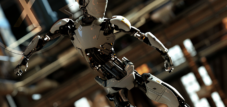Published on: April 20, 2025 / update from: April 20, 2025 - Author: Konrad Wolfenstein

Biomimetics in microrobotics with robobe and co.: How landing techniques of insects drive robotics - creative image: xpert.digital
Calculated from nature: how the biomimetics shifts the limits of robotics
Tiny helpers: Insect robots conquer agriculture, medicine and more
Nature has developed remarkable solutions for complex challenges over millions of years. It is precisely this efficiency and elegance of natural systems that increasingly inspire scientists in developing advanced robot technologies. The biomimetics inspired by insects has led to impressive breakthroughs, particularly in the area of microrobotics. Above all, the recent progress in landing techniques for micro -robots, which are inspired by insects such as snacks and bees, impressively demonstrate how nature can serve as a blueprint for innovative technical solutions.
Basics of biomimetics in robotics
Biomimetics, also known as Bionik, describes the systematic transmission of mechanisms and methods from nature to technology. This interdisciplinary approach is becoming more and more observed in areas such as material sciences, robotics, renewable energy, medicine and information technology. Instead of copying nature one to one, the scientists are concerned with understanding the underlying principles and adapting them for technical applications.
Engineers have always been inspired by nature, explains Hartmut Witte, head of the Biomechatronics department at Ilmenau. Bionics serves as a method of not only promoting and systematizing this association, but also to expand the basis for technical product developments. Evolution has produced organisms that have adapted perfectly to their environment, and it is precisely these adjustments that provide valuable role models for innovations in technology.
When transferring biological principles to technology, it becomes clear that true bionics are not recognizable by external characteristics, explains Witte. It is not about the mere imitation of the external form, but about the adaptation of the functional principles that were developed into perfection in nature.
Suitable for:
Insect -inspired micror robots: technical miracles in miniature format
Due to their size, efficiency and amazing skills, insects are available as ideal role models for the development of micro robots. Her highly developed flight characteristics, locomotion mechanisms and adaptation skills have inspired researchers worldwide to technically reproduce these biological systems.
Robobee: Harvard's flying micro robot
One of the best -known examples of insect -inspired robotics is the Robobee at Harvard University. This tiny flying robot weighs just a tenth gram and has a wingspan of only 3 centimeters. The RoboBee consists of three main components: the body made of carbon fiber, the wafer -thin wings and the "brain", which consists of a number of intelligent sensors.
The wings are powered by piezoelectric actuators - a kind of artificial muscles that convert electrical energy into motion. This technology enables the micro robot to fly, float and carry out complex maneuvers, such as a real bee.
More examples of insect -inspired micro robots
At the University of California, Berkeley, engineers have developed an even smaller insect -inspired flight robot. With a diameter of less than 1 cm and a weight of only 21 mg, it is the smallest wireless robot in the world that can fly in a controlled manner. Unlike the RoboBee, however, this robot uses external magnetic fields as a drive and control.
Bionik researchers at the Georgia Institute of Technology have in turn developed micro-robots that mimic the behavior of ants. These tiny robots are just 1.8 millimeters wide, 0.8 millimeters thick and weigh about 5 milligrams. The researchers' vision: Swarms of these electronic insects could take over the pollination of plants in agriculture.
The challenge of safe landing
One of the biggest challenges for flying micro robots is a safe landing. Due to their small size and light weight, they are particularly susceptible to air flailing and instabilities, especially near the ground.
The landing problem of the robobebee
"So far we have switched off the vehicle over the ground in a landing, just dropped it and prayed that it ends up and safely lands," explains Christian Chan, a doctoral student on the Harvard research team. This uncontrolled landing was a considerable risk for the sensitive piezoelectric actuators and filigree wings of the robot, which could easily be damaged by an impact.
The problem was exacerbated by the so -called so -called soil effect - air displacement that are triggered by the beating wings and lead to instability when landing. These aerodynamic challenges make it particularly difficult for tiny flight robots to end up in a controlled manner.
Land solution inspired by schnaken
To solve this problem, the scientists from Harvard University looked at the crane fly (schnake), an insect with similar dimensions as the robobe. The crane fly is able to carry out elegant landings on various substrates, thanks to their long, flexible legs that can steam landings.
Inspired by this natural model, the team developed a new landing stell for the Robobee: four long, flexible legs, similar to those of the crane fly. These legs are long and flexible enough to ensure that the ground is safe from the ground before the main body of the robot is affected by the problematic air turbulence.
In addition to the mechanical improvements, the scientists also adapted the robot's flight control, orienting themselves to the landing behavior of crane flying. These accelerate from a floating flight, then brake towards the landing goal and set up with a low impact speed. The still existing impact energy is then recorded by the mechanical landing area.
Alternative landing techniques for micro -robots
Another landing technology inspired by insects was developed by researchers at Harvard University for previous versions of the RoboBee. While real insects often use a kind of adhesive to adhere to vertical surfaces, the researchers relied on electrostatic attraction in order to attach the robot to a pad. This approach only requires a small amount of energy to fix the light robot.
Another remarkable development comes from the Nanjing University of Aeronautics & Astronautics (NUAA), where researchers have developed an insect robot that combines flight and climbing skills. This robot can land on a vertical wall, climb along it and take off again - a skill that he was able to demonstrate on different materials such as glass, wood, marble and even tree bark.
Biomimetic approaches beyond landing technology
Nature inspires robotics not only in the development of landing techniques, but in numerous aspects of microrobotics. From locomotion mechanisms to detention systems to drive concepts - nature offers a rich reservoir of solutions.
Advanced movement systems
A Harvard University research team has developed a micro insect robot called “Little Fury” with an artificial “cock” inspired by jumping cocks. This robot can jump impressive 1.4 meters, which corresponds to 23 times its body length. The jumping mechanism is based on the "Furcula" of the jumping cocks that work like a tense spring.
At the TU Ilmenau, researchers in the Biomechatronics department have built a small robot caterpillar, which is equipped with the so-called "Gecko-Tape". This material was inspired by the adhesive mechanisms of geckos, spiders and beetles, which can run on vertical surfaces and even on the ceiling without adhesive fluids.
Autonomous navigation and swarm behavior
Another important area of biomimetic robotics is autonomous navigation. Scientists from the Swedish University of Lund have developed a concept for a new drone orientation system based on the alternative behavior of insects. The observations have shown that bees are based on the light intensity in navigation to avoid obstacles.
Researchers in Hungary have again transferred the swarm behavior of insects to drones. With the help of a newly developed algorithm, up to nine individual aircraft can fly in formation and thus also navigate in confusing environments such as cities.
Suitable for:
- Humanoid Standing-up Control: Learn to get up with “host” humanoids-the breakthrough for robots in everyday life
Application potential and future prospects
The micro -robots inspired by insects promise a variety of applications in different areas.
Agriculture and environmental monitoring
One of the most fascinating potential applications is artificial pollination. In view of the global decline of bee populations, swarms of Robobees could one day help pollination of plants. In addition, these micro robots could be used in environmental monitoring to collect data on environmental conditions that are inaccessible to larger drones.
Exploration and disaster relief
Thanks to their small size, insect -inspired micror robots could be used when exploring narrow rooms, collapsed buildings or other complex environments. In disaster areas, you could provide valuable information without putting people in danger.
Medical applications
In the long term, miniaturized robots could even be used in the medical field. Swarms of tiny robots could possibly carry out diagnoses or even make treatments in the human body.
Current boundaries and future developments
Despite the impressive progress, insect -inspired micror robots are still facing considerable challenges. For example, the RoboBee is still connected to external control systems by cable, which limits its mobility. The researchers are working on miniaturizing sensors, control and energy supply in order to be able to install them directly in the flight robot.
The miniaturization of these components is considered the "triple sacred grail" of microrobotics and represents enormous technical challenges. Nevertheless, the vision of the researchers is clear: completely autonomous swarms of micro robots that can perform complex tasks in various environments.
Nature as an engineer: progress in microrobotics
Biomimetics have revolutionized the development of microrobotics by enabling engineers to benefit from millions of years of evolutionary optimization. The recent progress in insect -inspired landing techniques for micro -robots such as the robobe impressively demonstrate the potential of this approach.
Due to the imitation of natural systems, researchers not only develop more efficient and more robust robots, but also gain valuable insights into the biological mechanisms themselves. Like Alyssa Hernandez, Postdoctor and co-author of the RoboBee study, explains: “We can use these robot platforms for biological research and studies, the biomechanical hypotheses test. "
The future of biomimetic robotics promises further fascinating developments, while researchers continue to tap into the inexhaustible source of inspiration in order to master the technical challenges of our time. The path from the observation of natural phenomena to its technical implementation is not always easy, but as the success story of the RoboBee shows, it can lead to groundbreaking innovations that have the potential to revolutionize numerous areas of our lives.
Suitable for:
Your global marketing and business development partner
☑️ Our business language is English or German
☑️ NEW: Correspondence in your national language!
I would be happy to serve you and my team as a personal advisor.
You can contact me by filling out the contact form or simply call me on +49 89 89 674 804 (Munich) . My email address is: wolfenstein ∂ xpert.digital
I'm looking forward to our joint project.













